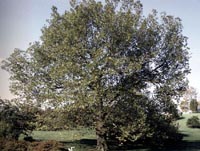Resource Library
Plant of the Week: Sycamore
The University of Arkansas System Division of Agriculture does not promote, support or recommend plants featured in "Plant of the Week." Please consult your local Extension office for plants suitable for your region.
Plant of the Week
Sycamore
Latin: Platanus occidentalis

Saving grand old trees from destruction always entails a battle. The Western version of property ownership -- "I own it -- I can do with it as I please" is well established in our culture and will remain with us as long as our society survives.
But, this absolute ownership is still subject to rules and regulations. Everyone from Bill Gates to the developers building a department store in Fayetteville complain of the unfairness of these rules, but our society is none-the-less based on the fair and even handed application of rules. Sycamore trees are not on anyone’s first choice of landscape trees. They get too big -- often 150 feet tall and wide. They seem to drop things during much of the year -- either their peeling bark, large leaves in the fall or their fuzz-ball seeds in the spring. And they get disease. Sycamore anthracnose knocks the leaves off just as they emerge in the spring and is common most years. Fortunately the disease never seems to kill the tree, just makes it look ugly.
But even a lowly sycamore is worthy of protection if it has attained sufficient size and dignity. Mrs. Alice Lloyd at Pippa Passes, Ky., was the first person I am aware of to emancipate a tree. In her will, she deeded the ownership of the tree and the ground on which it stood to the tree. The will states "For, and in consideration of its shade, coolness and inspiration, and in value of itself as an aesthetic asset the parties of the first part hereby convey to the part of the second part in trust for the use and benefit of said sycamore tree, and to itself as absolute owner, the said tree and the said terra firma, the ground upon which it stands is to belong to itself."
Her sycamore finally died in 1941 after a 150-year-life span, but since then other trees have been granted ownership of themselves across the country.
The most common complaint one hears about the issue of saving old and important trees revolve around the issue of property ownership. True, the developers own the property and the trees, but the citizens of a community own the market into which the new business wishes to participate. The price of admission to that market is adherence to the wide assortment of rules and regulations which the city has in place, including the tree ordinance.
Should a gardener be looking for a sycamore tree for the landscape, a far better choice is the London Plane tree. This tree is a sycamore look-alike but it is smaller, disease resistant and more tidy. The leaf size is about one third the size of our native sycamore and ultimate tree size is about 75 feet tall and broad. It develops a beautiful white bark with age. Instead of a single ball of seeds, the London Plane tree has a series of three to five balls in an elongated string like ear-bobs. The tree is adaptable to most growing conditions and has been used in difficult street tree locations. It is adapted statewide.
By: Gerald Klingaman, retired
Extension Horticulturist - Ornamentals
Extension News - May 26, 2000
The University of Arkansas System Division of Agriculture does not maintain lists of retail outlets where these plants can be purchased. Please check your local nursery or other retail outlets to ask about the availability of these plants for your growing area.